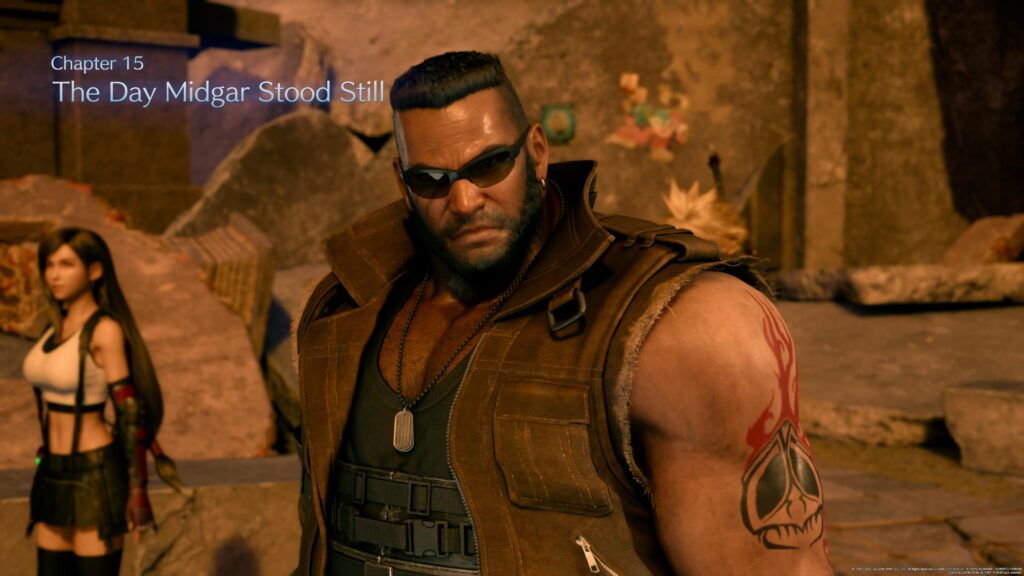When I first watched some of the footage from the highly anticipated (but mired in development issues) Final Fantasy 7 Remake, I had two immediate thoughts: Gee this looks pretty, followed by I don’t like how they changed the gameplay. Having now played through the Playstation 5 port of the game I can say that the game does indeed look spectacular and the combat took some getting used to but eventually grew on me. Unfortunately, the game suffered the most from an issue I was not aware of until I was ten or so hours in.
Final Fantasy 7, developed and published by Square Enix, is considered one of the most influential role-playing games out there. It was responsible for kicking the franchise into a grittier world and more engaging story than anything which had come out before it and stuck out in gamers’ minds as one of the best games of the decade, originally released for the Playstation 1 back in 1997. What Square attempted to do here is bring it into the cur- rent generation of consoles and gamers in as many facets as possible.
To start, the gameplay is completely changed from the original Playstation 1 version. In the original, you’d need to wait for a character’s action gauge to fill before being able to make an attack, cast magic, or use an item. No movement options were available aside from whether to position your characters in the front or back row when fighting enemies. Here in the remake, combat takes on more of an action style. You’re given full movement of your character during fights and can attack or block at the push of a button, though special attacks and magic are still locked off behind an action meter which fills over time.
This system works well, but I wish that they also included a proper “Classic” battle style as well. The classic style which Square Enix provided simply takes away full control from the player and only lets you pick the special attacks when a character’s bar is full. While a full implementation of the traditional turn-based combat would have required quite a bit of work to balance, in its current state this compromise between the two styles felt half-baked and I played the majority of the way through the game using the new combat style and forgoing classic completely.
One area of the game which I’m hard-pressed to find fault with is its presentation. Combat looks flashy, filled with dazzling effects with each sword blow or gunshot. Everything in the Remake looks eons better than it did in its original version – as well it should be – on a console which isn’t pushing thirty. On Playstation 5, especially, this game looks gorgeous in 4K resolution and up to 60 frames-per-sec- ond. It should also be noted that the PS5 version also incorporates a few extra graphical punches over the version which released on PS4, namely improved lighting, skyboxes, and fog in a number of areas.
The music has also received a significant facelift. While the original version relied on synthesized instruments to provide its score the new version makes use of real musicians and new arrangements. Classic themes are remade and are given new legs to stand on in this version, and I found myself listening to some of the standout tracks on repeat. My personal recommendation is the Sector 7 Slums song, which instilled in me the same sense of adventure and wonder when I first heard it as a child.
The core story is the same in both the original and remake. The hero of the story, Cloud Strife, joins an eco-terrorist group named Avalanche, intent on destroying energy reactors which harm the planet in order to power Midgar, a large city home to the evil corporation Shinra. While they manage to destroy some of the reactors Shinra does not take this lying down and attempt to quash Avalanche by any means possible. The game sprawls out from there, introducing new protagonists and antagonists. A few new story twists are also thrown in, though without going into detail my opinion on them is mixed.
While the remake does a wonderful job maintaining the original’s art style and musical flourishes it struggles when it comes to any of the new story and side quest content. There is usually a clear divide between what was old and what had been added in for this remake. One has to look no further than the Hobbit movie trilogy compared to what the book set out to do. Characters which had little to no screen time in the original game now take up hours of the game’s thirty-hour runtime and most of their screen time does little to properly advance the story. Take Jessie, one of the members of Avalanche who hardly gets any dialogue in the original game. Now she has an entire story arc and a romantic interest with Cloud. This last change alone is the most egregious to me, changing Cloud’s love triangle with two other female characters into a love square. The game didn’t need another source of romantic tension and I feel suffers from its inclusion. Most of the new additions and changes make me feel this way, that they were unnecessary at best. The side quests also felt fairly arbitrary. The original game didn’t have any to the extent that they’re present here and the original’s side content was not delineated as clearly as the remakes. That may sound like a complaint but I enjoy stumbling across extra content compared to talking to a person simply because they have a marker floating above their head. Overall, the remake is taking a story which already has quite a few working parts to it and throwing even more into the mix. Just like The Hobbit, it’s drawing-out what didn’t need to be drawn out.
This drawing-out comes with another crutch as well. Final Fantasy 7 Remake is only roughly the first quarter of the original. The plan is to release sequels to the game which will fill out the rest of the story (again, see the Hobbit trilogy). I’m of two mind- sets here. Games are only becoming more complicated to make and a game with the scope of Final Fantasy 7 would be a massive undertaking to remake from the ground up, start to finish. But what Square Enix essentially did was to provide a window into what the rest of the remake would look like, and so far, I’m not entirely convinced that they’re on the right track.




